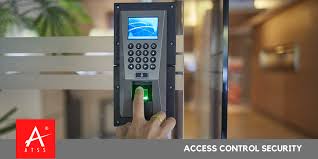Access control systems are an essential component of modern security systems. They are designed to limit access to buildings, rooms, or specific areas within a facility. Access control systems can be used in a variety of settings, including commercial buildings, hospitals, schools, and government facilities.
Access control systems typically consist of three main components: the access control panel, the access control reader, and the locking mechanism. The access control panel is the brains of the system and is responsible for managing access rights and permissions. The reader is used to authenticate users by reading their credentials, such as a keycard or biometric data. The locking mechanism is used to secure doors or gates.
There are several types of access control systems available in the market. Some of the most common types include:
- Card-based access control: This type of system uses smart cards or proximity cards to grant access to authorized personnel.
- Biometric access control: Biometric access control systems use unique physical characteristics such as fingerprints or facial recognition technology to verify a person’s identity.
- Keypad-based access control: This type of system requires users to enter a PIN code on a keypad to gain entry.
- Mobile-based access control: With mobile-based access control systems, users can use their smartphones as their credentials for gaining entry.
Access control systems offer several benefits over traditional lock-and-key systems. One significant advantage is that they provide real-time monitoring capabilities that allow facility managers to track who enters and exits specific areas at any given time. This information can be used for security purposes or for tracking employee attendance.
Access control systems also offer greater flexibility in terms of granting and revoking permissions for specific individuals or groups based on their roles and responsibilities within an organization. This means that facility managers can easily adjust permissions based on changing circumstances such as employee turnover or departmental restructuring.
In conclusion, access control systems are an essential component of modern security solutions that provide enhanced security, flexibility, and real-time monitoring capabilities. With the increasing importance of security in today’s world, access control systems are becoming increasingly popular and are an investment that no facility manager can afford to overlook.
Top 5 FAQs on Access Control Systems: Types, Costs, Benefits, Set Up and Features
- What types of access control systems are available?
- How much do access control systems cost?
- What are the benefits of using an access control system?
- How do I set up an access control system?
- What features should I look for in an access control system?
What types of access control systems are available?
There are several types of access control systems available in the market. The most common types include:
- Card-based access control: This type of system uses smart cards or proximity cards to grant access to authorized personnel. The card is programmed with specific information that allows the reader to identify the user and grant or deny access based on their credentials.
- Biometric access control: Biometric access control systems use unique physical characteristics such as fingerprints, facial recognition, or iris scans to verify a person’s identity. This type of system is highly secure, as it is difficult to replicate someone’s biometric data.
- Keypad-based access control: This type of system requires users to enter a PIN code on a keypad to gain entry. The PIN code can be changed periodically for added security.
- Mobile-based access control: With mobile-based access control systems, users can use their smartphones as their credentials for gaining entry. This type of system is convenient as users do not need to carry an additional card or key fob.
- Proximity-based access control: Proximity-based systems use radio-frequency identification (RFID) technology to grant access to authorized personnel. The user carries an RFID tag that communicates with the reader when they are in close proximity.
- Smart lock systems: Smart locks are electronic locks that can be controlled remotely using a smartphone app or other connected device. They offer enhanced security features such as automatic locking and unlocking based on user proximity.
Each type of access control system has its own advantages and disadvantages, and the choice of system will depend on the specific needs and requirements of the facility being secured.
How much do access control systems cost?
The cost of access control systems can vary widely depending on several factors, such as the size and complexity of the system, the type of access control technology used, and the number of doors that need to be secured.
A basic card-based access control system for a single door can cost anywhere from $500 to $1,500. A more advanced biometric access control system with multiple readers and locking mechanisms can cost upwards of $10,000 or more.
Other factors that can affect the cost of an access control system include installation fees, ongoing maintenance costs, and any necessary upgrades or replacements over time.
It’s important to note that while access control systems may seem like a significant investment upfront, they can ultimately save money in the long run by reducing the need for physical keys and locks, improving security and monitoring capabilities, and minimizing the risk of theft or unauthorized access.
Ultimately, it’s best to consult with an experienced security professional or vendor to get a more accurate estimate of how much an access control system would cost for your specific needs.
What are the benefits of using an access control system?
Access control systems offer several benefits over traditional lock-and-key systems. Here are some of the main advantages:
- Enhanced security: Access control systems provide a higher level of security than traditional lock-and-key systems. With access control, you can restrict access to certain areas of your facility based on job roles, department, or other criteria. This ensures that only authorized personnel can enter sensitive areas and reduces the risk of theft, vandalism, or other security breaches.
- Real-time monitoring: Access control systems provide real-time monitoring capabilities that allow you to track who enters and exits specific areas at any given time. This information can be used for security purposes or for tracking employee attendance.
- Greater flexibility: Access control systems offer greater flexibility in terms of granting and revoking permissions for specific individuals or groups based on their roles and responsibilities within an organization. This means that facility managers can easily adjust permissions based on changing circumstances such as employee turnover or departmental restructuring.
- Improved audit trail: With access control systems, you have a detailed audit trail that shows who accessed specific areas and when they did so. This information can be used to investigate security incidents or to comply with regulatory requirements.
- Reduced costs: Access control systems can help reduce costs associated with lost keys or rekeying locks when employees leave the organization. With access control, you can simply deactivate a user’s credentials without having to change locks or issue new keys.
Overall, access control systems provide enhanced security, real-time monitoring capabilities, greater flexibility, improved audit trails, and reduced costs compared to traditional lock-and-key systems.
How do I set up an access control system?
Setting up an access control system can be a complex process, but the following steps will help you get started:
- Determine your security needs: Before you begin setting up an access control system, it’s important to determine your security needs. This includes identifying the areas or rooms that need to be secured, the number of users who will require access, and the level of security required.
- Choose the right type of access control system: There are several types of access control systems available in the market. Choose a system that best suits your needs and budget.
- Install the access control panel: The access control panel is the central component of any access control system. Install it in a secure location that is easily accessible for maintenance purposes.
- Install the readers: Access control readers are used to authenticate users and grant or deny access based on their credentials. Install them at all entry points, including doors and gates.
- Install locking mechanisms: The locking mechanism is used to secure doors or gates once they have been authenticated by the reader. Choose a locking mechanism that is appropriate for your specific application.
- Set up user accounts: Create user accounts for all individuals who require access to secured areas. Assign appropriate permissions based on their roles and responsibilities within your organization.
- Configure the software: Configure the software to manage user accounts, permissions, and other settings.
- Test the system: Test the system thoroughly before deploying it in a live environment.
- Train users: Provide training to all users on how to use the access control system correctly.
- Maintain and update regularly: Regular maintenance and updates are essential for ensuring that your access control system remains secure and functional over time.
Overall, setting up an access control system requires careful planning, attention to detail, and expertise in security systems installation and management. If you’re not confident in doing it yourself, consider hiring a professional security company to help you set up and maintain your access control system.
What features should I look for in an access control system?
When choosing an access control system, there are several key features that you should consider to ensure that the system meets your needs and provides the level of security and flexibility that you require. Here are some of the most important features to look for:
- Authentication methods: Look for a system that supports multiple authentication methods, such as smart cards, biometrics, or PIN codes. This will give you greater flexibility in terms of how users can gain access.
- Scalability: Make sure that the system can easily scale up or down to accommodate changes in your organization’s size or structure.
- Integration with other systems: Consider whether the system can integrate with other security systems, such as CCTV cameras or intrusion detection systems.
- Real-time monitoring: Look for a system that provides real-time monitoring capabilities so that you can track who is accessing specific areas at any given time.
- Access permissions: Make sure that the system allows you to set granular access permissions based on user roles and responsibilities within your organization.
- Reporting and analytics: Consider whether the system provides reporting and analytics capabilities so that you can track usage patterns and identify potential security risks.
- Ease of use: Look for a system that is easy to use and manage, with an intuitive user interface and straightforward administration tools.
- Reliability: Make sure that the system is reliable and has a proven track record of uptime and performance.
By considering these key features when choosing an access control system, you can ensure that you select a solution that meets your needs both now and in the future.




